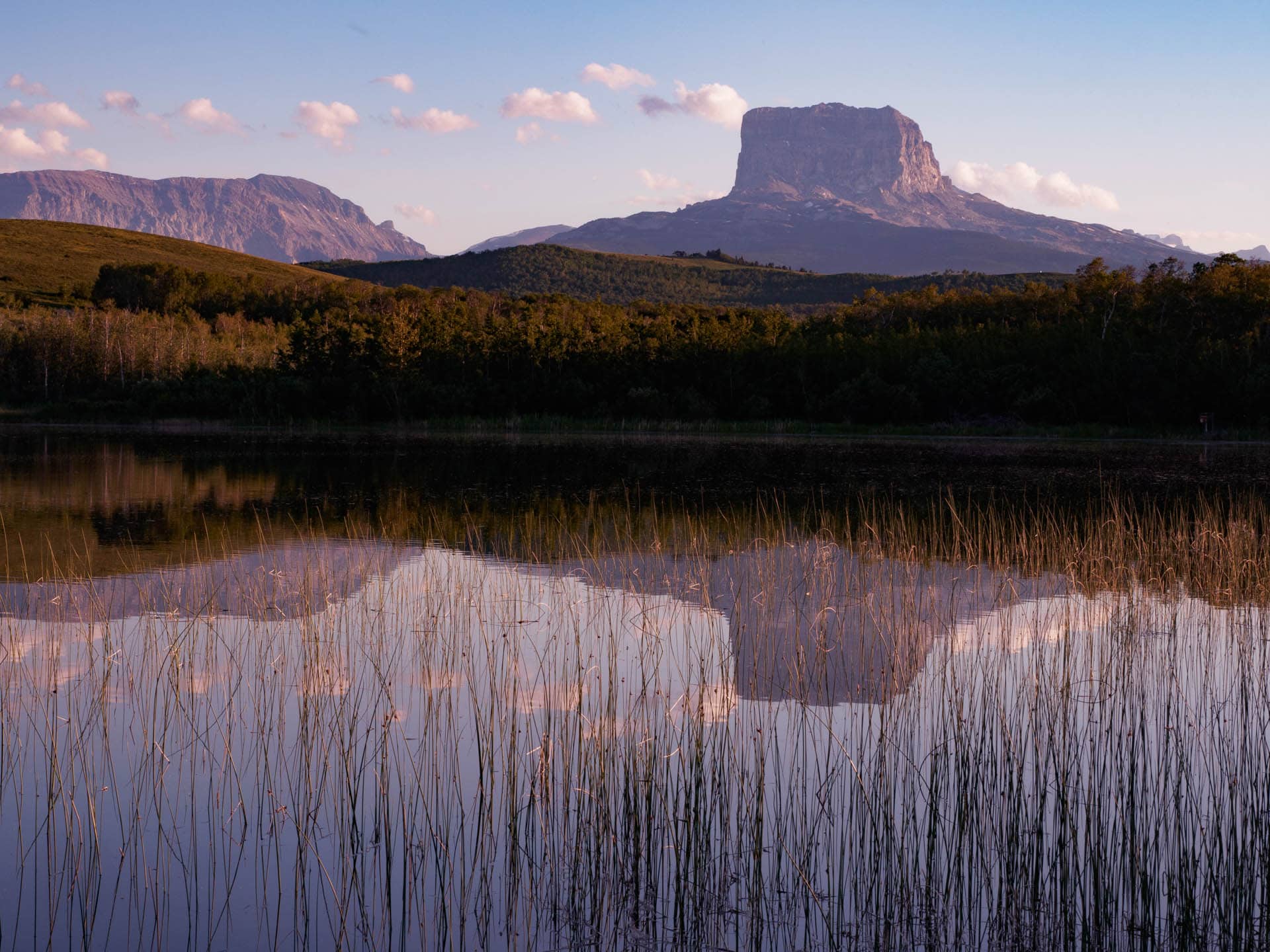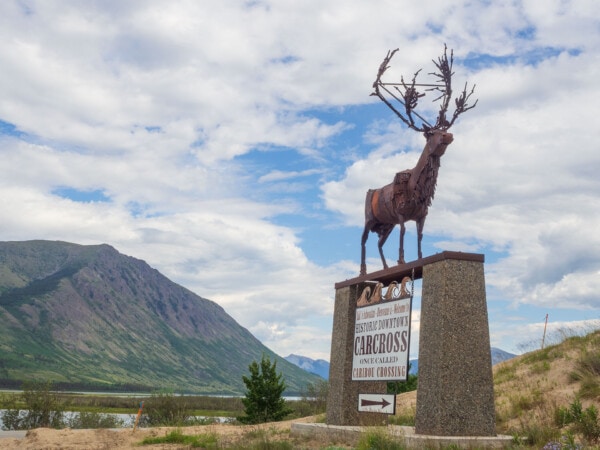Were it not for our friend Karol, Magellan and I would have stayed in Waterton Park’s townsite campground, Rove-Inn side-by-side with 237 other rigs, moving each night for our four-day stay because it was so busy we couldn’t book consecutive nights.
“Have a look at Police Outpost,” Karol said. “It was one of our favourite places to camp and it’s only a 35-minute drive from Waterton. Don always said it was one of the places he wanted his ashes to be spread.”
One quick look at the website for Police Outpost Provincial Park and Magellan clicked to another screen to cancel our reservations at the warehouse campsite and book site #35 at Police Outpost.
After leaving Highway 501, near Beazer with Rove-Inn pointed south to Police Outpost on Range Road 270, we cheered Karol’s recommendation. The paved and gravelled highway was empty this far out in the undulating ranch land. The vaulted sky was an arresting blue, cloud-free. The grass was spring green and whisper silent. Chief Mountain in Montana, one of the most prominent peaks in the Rockies, stood guard, nearly 2,800 metres tall, its view a highlight of Police Outpost, its distinctive square shape visible for miles.
As you’d expect from its name, Police Outpost used to be a base for the Northwest Mounted Police. At an elevation of 1,390 metres, from its highest point the NWMP (and now us) had a three-hundred-sixty-degree view of the entire park, from prairie ranches to mountain peaks. Established in 1891, the outpost was ideally located for the NWMP to curb the illegal smuggling from the US into Canada of whisky, more a “watery alcohol mixed with chewing tobacco, molasses, ink, painkillers and anything else on hand.” (Our nights at Police Outpost were cool enough that Magellan opened the bottle of American bourbon whisky he received for Fathers’ Day.)
Nestled into an aspen forest, the 46 sites, each varying in size, are spaced apart on a circular loop. The sites are unserviced but luckily, RVers near us didn’t run their generators at night and on the Sunday we arrived, fewer than half the sites were occupied.
Karol had told us about the upper trail south of the campground that leads to the Canada/US border and Outpost Wetlands Natural Area where she and Don, both superb photographers whose work has appeared in The Globe and Mail and graced many Nature Conservancy publications, often hung out waiting for Trumpeter Swans to appear. Although Magellan and Don both went to Walter Murray High School in Saskatoon, Don was four years older and known to Magellan only as the school photographer, a cool guy. In 1978 Karol and I met at University Elementary, a progressive demonstration school for education students at the University of Calgary. The four of us became good friends. Don, who graduated from high school the year Rachel Carson’s Silent Spring changed the world, had a successful 40-year career as an environmental consultant. He advised the oil and gas company Magellan worked for, the two of them spending a memorable day at the farm of Weibo Ludwig, a controversial anti-oil-patch activist and convicted bomber. Later, Magellan was on the board of a company Don co-founded, and I helped the firm with its communications. Don and Kerry became diving buddies, receiving their rescue-diving certificates in Waterton Lake’s icy waters. The four of us holidayed in Fiji where Karol and I (her eustachian tubes too small, she had a valid excuse for not diving, unlike me) saw more sea creatures snorkelling near shore than our partners did deep-water diving. Beyond the annual “Spaghetti Feed” Karol and Don hosted for dozens of people over many years, we shared dozens of meals and many bottles of wine (Don was a connoisseur) at each other’s homes.
Although Karol was told the Wetlands Natural Area was open when she called to check for us, the sign indicated it was closed until July 31 to ensure the Trumpeter Swans were not bothered while their cygnets were young. And with a border camera aimed at our heads, we weren’t about to become wanted outlaws.
Besides, on the upper trail my quest in coming to Waterton Lakes National Park—to see its abundance (800 species!) of wildflowers—had already been successful. The park’s prairie-to-peak ecosystems make it one of the best places in the world for wildflowers—more than 50 of Canada’s rarest grow here, 20 found nowhere else in the country. Borne by the area’s legendary winds, many wildflower seeds flew the park to Police Outpost, emblazing the four-kilometre Boundary Creek Trail that swings westward and loops back to the campsite through fescue grassland with Wild Rose pinks and Larkspur blues, Columbine yellows and Glacier Lily whites.
After dinner our first night, we walked a well-developed trail around Outpost Lake only a few hundred metres north of the campsite. A haven for birds and other wetland creatures, the lake attracts boaters interested in birdwatching and trout fishing. Mostly hidden from view by a thicket of willows hugging its shoreline, the lake, if you don’t have a boat, is best viewed from the boardwalk on the western side that leads to a small island with an open trail around its perimeter. In the silence, listening to the throaty singsong of what we assumed were bull frogs, we were so enchanted that darkness had softened the prairie light by the time we returned to our camp spot.
Every day we looked forward to the drive “home” from hiking in Waterton. Mostly silent. Especially Wednesday night after spending the day with Karol. I thought about the last time we saw Don. August 10, 2012, Banff Centre’s Amphitheatre, an Emmylou Harris concert. Did she sing, “The key to my heart/You hold in your hand?” Surely the lyrics that describe Don and Karol’s lock-fast love.
Karol and I, along with other friends, formed a book club this spring. We’re currently reading Through the Garden, A Love Story (with Cats), Lorna Crozier’s memoir of her life with Patrick Lane, the passionate devotion of Canada’s poetry-power couple to their writing and to each other. The quote from St. Augustine that Lorna gives to encapsulate their relationship also reflects the intimate companionship Don and Karol poured into their shared art of photography and reverence for the natural world and each other:
Such is each as is his love.
Navigation
This post is dedicated to our friend Don. The photo of he and Karol was taken by Marny Dabbs.
Crozier, Lorna. Through the Garden, A Love Story (with Cats). Toronto: McClelland & Stewart, 2020. “… a testament to poetry, love and longing,” writes Steven Price on the flyleaf. “Lorna Crozier reminds us that remembering lies at the heart of who we are. This is one of the great love stories of our time.”
Karol linked us to Hinterland Who’s Who for more about Trumpeter Swans. On the verge of extinction, there were only 77 Trumpeter Swans (in all of Canada!) in 1933. The species is no longer considered in danger of extinction because of an intensive international conservation effort, but the Rocky Mountain Population is not growing as rapidly as the one on the Pacific Coast. Trumpeter Swans in the Rockies are vulnerable to catastrophic losses from disease, habitat destruction and in places like Waterton, the affects of exceptionally cold winters.
Lavoie, Jacinthe and Wilson, Ian. Wildflowers of Waterton Park. Canmore: Hyacinth Press, 2014. A great resource for flower enthusiasts including which trails you’re most likely to find each flower.
Porsild, A. E. Rocky Mountain Wildflowers. Ottawa: National Museum of Natural Science, National Museums of Canada and Parks Canada Department of India and Northern Affairs, 1974. Our wildflower bible for hiking but less valuable for wildflower identification in Waterton than Jacinthe’s and Ian’s book.
Shaw, Richard J and On, Danny. Plants of Waterton-Glacier National Parks. Missoula: Mountain Press Publishing Company, 1979. Wrinkled, pages looking for freedom, this book was hidden away, a treasure I discovered in our library after we returned from Waterton.




































4 Responses
Thank you, Kerry & Gloria, for your beautiful description of one of my very favourite places. Police Outpost has given me many special memories of amazing landscapes and wildlife encounters. Thank you for the enduring friendship we have.
Our pleasure. We plan to add to our memories of Police Outpost, maybe as soon as next year during the spring wildflower season.
Interesting that you mention the bane of all and actually any camping area, generators. I have three but they are basically used in emergency situations, one EU1000 Honda is very close to quiet but the others are beyond noisy.
I have left campgrounds because of the noise and went to a quieter spot, no need to try and enjoy nature with a racing engine, not going to happen.
If you need to use a generator to charge a battery in a dead vehicle, OK that’s allowed. But to run a generator to run a TV or stereo, you should stay home as your not there to enjoy nature, not only that your annoying everyone else around you. Run your Genny around noon, everyone is up and your disturbance is minimal, run for a max of two hours, if you need to run longer you have a battery problem or system problem. I have a 4D battery on our trailer, this is roughly 20 inchs long, 10 inch wide and 10 inch deep. This will last beyond all weekend long and beyond without recharging and will be recharged by the time we get home by the tow vehicle. Keep your battery clean, connections tight and you have won half the battle.
Police Outpost is my kind of campground, no services beyond, fire pit, table, outhouse, and most important close to nature.
Perfect
Nice artical👍👍👍👍👍
Might have to make multiple copies of your advice for future taping on the windshields of fellow campers!